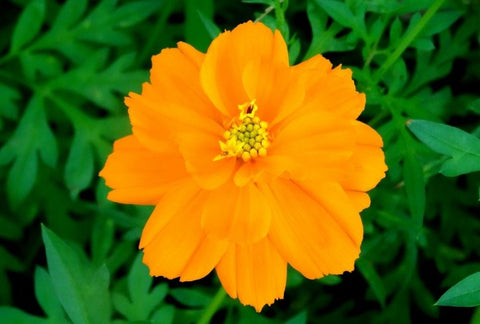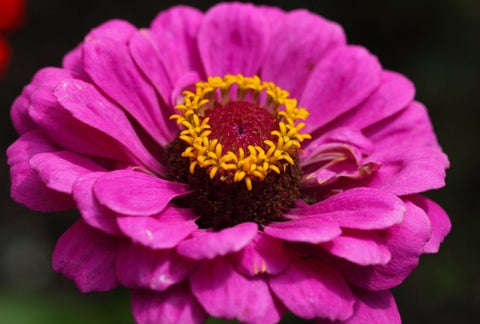Cosmos flowers are often used to symbolize order and harmony, due largely to the flower’s harmonious petals.

Timing
Sprouts in 1-2 weeks. Harvest from Month 3+ on.

Full sun
Equivalent of 7+ hours of direct sun [DLI of 21+ mol/m²/day].

Care
Beginner friendly. You’ll sprout, thin, and deadhead.
Are Cosmos Edible?
Yes, certain species of cosmos are edible. These include Cosmos sulphureus, Cosmos bipinnatus, and Cosmos caudatus (Mexican Aster). Especially if you grow organic cosmos seeds and use non-chemical plant food, you can eat the petals of cosmos flowers and add them to your salads.
Growing Cosmos: Best Cosmos Varieties to Grow Indoors
Cosmos flowers can be successfully grown in containers. They can grow as much as 6 feet tall, so we recommend that you look for dwarf or compact cultivars for indoor growing. Here are our favorites:
Garden
Has very attractive flowers throughout the summer. Also attracts bees, butterflies, and birds to your garden.
AmazonSulphur
They are a lovely addition to your home and edible, too! Toss a few of the zesty petals into your favorite soup or salad, or just eat straight off the plant as a snack!
AmazonChocolate
Makes wonderful and exotic cut flowers and does a great job at attracting butterflies to your garden.
AmazonHow to Grow Cosmos: Best Setup for Cosmos Plants
You’ll Need:
Planter or Pot for Your Cosmos:
Ceramic Self-Watering Planter (preferred) or pot that is at least 12″ / 5 gal.
Soil:
Standard Potting Mix
Plant Food:
At the start: Balanced Blend. This should be equal parts nitrogen, phosphorus, and potassium (with NPK numbers like 10-10-10).
Ongoing: Vegetable Blend. This should be high in phosphorus and low in nitrogen (with NPK numbers like 4-10-6).
Do Cosmos Need Full Sun? Grow Lights for Your Cosmos:
A strong grow light that can give the equivalent of 7+ hours of direct sun [DLI of 21+ mol/m²/day].
Jump to: Our product recommendations
Preparing Your Planter & Watering Schedule for Cosmos
Cosmos plants do well in moist soil conditions. If the soil dries out completely, the roots will die back and it will be tough for the plant to recover. On the other hand, if the roots are exposed to standing water for too long, they can rot.
A Ceramic Self-Watering Planter filled with a standard potting mix self-regulates to keep the soil at consistent moisture for your plant to thrive (and no watering guesswork for you).
To set one up:
- Fill up the planter with dry soil from the bag, gently tamping down the top.
- Dump the soil into a large mixing bowl and add water until the soil is moist, but not sopping wet (about ½ Cup).
- Mix in 1 tablespoon of the Balanced Blend Plant Food.
If you are using a regular pot instead, it should be a little bit bigger (at least 12″ / 5 gal) and will need drainage holes to prevent it from being over-watered. Let the top of the soil dry out between watering.
Starting Your Cosmos: Seed vs Cutting vs Nursery Plant
New cosmos plants can be started from seed, propagated from an established plant, or purchased live at many garden centers. We prefer to sprout from seed or propagate from a stem cutting, as it results in plants that are adapted to your growing conditions and limit the chances of accidentally bringing home pests.
Growing Cosmos: How to Plant Cosmos Seeds

Cosmos grow quickly from seed. Plant 2 sites in a 12″ / 5 gal container. In larger containers, space sites 4″ apart. For each site, plant 2 seeds 1/4 inch deep. Keep the soil warm (70-90°F, ideally 75°F). Sprouts typically appear in 7 days but can be as quick as 5 days or as long as 10 days depending on your conditions.
Propagating Cosmos: How to Clone from a Stem Cutting

If you’ve already got a cosmos plant you love (or a friend does!), you can easily clone it with just sharp scissors and a clean glass of water. First, cut a couple of 6” shoots of new growth (avoid anything woody). Next, remove the lower leaves so the bottom half is just stem. Place in a glass with 3” of water, making sure the cut leaf spots are underwater. Place the glass on a bright windowsill and change the water every few days. In a couple of weeks, roots should emerge and you can transplant them into your container. While using additional rooting hormones won’t hurt, it’s not necessary with cosmos plants.
- Cut 6” section of new growth.
- Remove leaves halfway and place in water on a sunny windowsill.
- Wait 14 days for a few ½ inch roots to form and carefully transplant into its final container.
How to Transplant Cosmos

Live starter plants give you a big jump start on your first harvest. When you’re in a garden center, pick the bushiest plant available (tall and lanky ones will be weak growers) and give it a good inspection for pests. Leaves should be dark green without holes, spots, or curled edges. A best practice is to “quarantine” your plant for about a week after bringing it home to ensure it’s free of pests.
- Remove some soil from its final planter, leaving enough space for the bottom of the seedling to be just higher than the soil surface.
- Hold the base of the stem with one hand, turn the pot over, and gently pull the seedling. Squeezing the pot can help dislodge it.
- Place in its final container and fill around it with soil, ensuring it’s tight but not compacted.
Growing Cosmos: Where to Grow Your Cosmos Plants
Cosmos plants have the highest light needs of any plant. Unless you have a totally unobstructed southern-facing window and plan on only growing in the summer, you’ll need a grow light. We recommend supplementing sunlight with a grow light. For an introduction to grow lights, check out our guide on grow lights for indoor gardeners and our buying guide for screw-in types. We recommend the 24W Screw-in Bulb by Sansi.

How Bright Should Your Grow Light Be?
Cosmos plants need the equivalent of 7+ hours of direct sunlight [DLI of 21+ mol/m²/day] to grow their best. The 24W Sansi bulb should be placed 6 inches away from the top of the plant, providing a PPFD (the standard measure of brightness) of 500 μmol/m²/s.
How Many Hours Per Day Do Your Cosmos Plants Need Under a Grow Light?
Cosmos plants are known as “short-day” plants, meaning they’ll develop faster if they sense over 12 hours of darkness. We recommend setting up a timer to leave the light on for only 10 hours per day.
Growing Cosmos: Cosmos Plants Grow Faster in Warmer Temps
Cosmos plants are called “warm-weather crops” and will speed up their metabolism when temperatures are warmer. However, if things get too hot, they’ll wilt and become prone to disease. Ideal temperatures are around 80°F, but anything between 65 and 100°F works well.
Week 1-2: Check for Sprouts
You could see seedlings in as little as 5 days (though 7 days is more typical). If it’s been 10 days and you still don’t have any sprouts, it’s likely that your setup is too cold.
Week 3: Thin Your Seedlings

Thin your planter to only have 1 seedling per site, leaving the largest plant. If you are using the recommended planter (at least 12″ / 5 gals), this will mean you’ve got 2 plants after thinning. By getting rid of the smaller seedlings, you’re allowing the biggest and strongest one to flourish by reducing its competition for water, food, and space.
If your seedlings are under 1 inch, stretching out, or folding over, it’s likely that they don’t have enough light.
Month 3+: How to Harvest Cosmos
Pick flowers right as they open to encourage more flowers to grow. If you let flowers go to seed on the plant, it will start to end their life cycle, so you should “deadhead” (remove the old flowers) to prolong the flowering season. If you fall behind, you can cut the plant by one-third, which produces a second flush of leaves and flowers.
Year 1: End of Life
You can prolong your cosmos life by pruning it and removing flowers before they have a chance to go to seed, but eventually, it will die. At this time, it’s best to clear the plant and start over.
Shop This Blog to Start Growing Cosmos
The right supplies can take the guesswork out of caring for your plants and turn care from a daily to weekly routine. Through our grow tests, we’ve found these products to produce the best indoor cosmos (and also have simple maintenance). Plants are adaptable and can grow in many different conditions, so they are by no means necessary if you already have other supplies.
Best Containers for Cosmos: Ceramic Self-Watering Planters
Plants thrive on consistent moisture but can suffer if they’re waterlogged. A semi-porous ceramic self regulates ideal conditions. Our favorite is the COSWIP planter. Runner up is the XS Self-Watering Planter by Wet Pot.
Best Soil for Cosmos: Standard Potting Mix
Cosmos likes a rich and moist root zone, so you are best off with a standard potting mix. We like this Potting Mix by Rosy Soil.
Best Nutrients for Cosmos: Balanced Blend followed by Vegetable Blend
Cosmos likes to start with nutrients that are equal parts nitrogen, phosphorus, and potassium (with NPK numbers like 10-10-10). For this Balanced Blend, we recommend Dr. Earth All Purpose.
Once they are growing, it’s better to use plant food that is high in phosphorus and low in nitrogen (with NPK numbers like 4-10-6). For this Vegetable Blend, we recommend Joyful Dirt Tomato & Herb.
Best Light for Cosmos: DIY or Soltech
There is a very small chance that you have the bright windows needed to grow these without a grow light. If you are looking for a higher-end option, we love the Aspect Light by Soltech. For a more affordable option, a DIY setup using a 24W Screw-in Bulb by Sansi with a Clamp Light and Timer works well too. Check out our complete guide on a DIY setup for less than $40 or our buying guide for screw-in bulbs.
Shop This Blog to Start Growing Cosmos
The right supplies can take the guesswork out of caring for your plants and turn care from a daily to weekly routine. Through our grow tests, we’ve found these products to produce the best indoor cosmos with simple maintenance. Plants are adaptable and can grow in many different conditions, so they are by no means necessary if you already have other supplies.
Happy Gardening!








There are no comments for this article. Be the first one to leave a message!